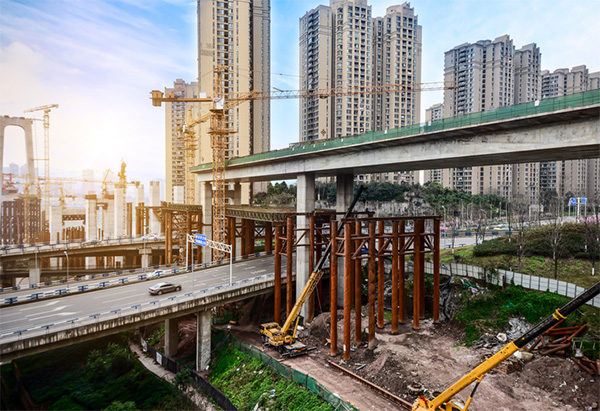Biden, Trump infrastructure plans as different as the candidates themselves
If you go to JoeBiden.com and read the Democratic presidential candidate’s $2 trillion plan “to build a modern, sustainable infrastructure and an equitable clean energy future,” there is in stunning detail a blueprint for a sustainable future. By contrast, President Donald Trump’s website offers plans on how to vote, how to donate money, a three-minute video of “promises made, promises kept” and an online shop for Trump swag.

If you go to JoeBiden.com and read the Democratic presidential candidate’s $2 trillion plan “to build a modern, sustainable infrastructure and an equitable clean energy future,” there is in stunning detail a blueprint for a sustainable future.
There are details about the need to build a modern, sustainable infrastructure now. Also included is talk about how to create “millions of construction, skilled trades, and engineering workers to build a new American infrastructure” and clean energy economy.
There is talk of rebuilding roads, bridges, green spaces and water systems as well as improving electricity grids and providing universal broadband for all. There are details on how to build high-quality, zero-emissions public transportation options through flexible federal investments.
There’s also talk about details of improving housing efficiency, upgrades and something called “environmental justice.” There’s even talk of smart roads, water systems, municipal transit networks, schools, as well as airports, rail, ferries and ports.
“Americans deserve infrastructure they can trust: infrastructure that is resilient to floods, fires, and other climate threats, not fragile in the face of these increasing risks,” the plan says. Biden wants “the movement of goods and people faster, cheaper, cleaner, and manufactured in America while preserving and growing the union workforce.”
By contrast, President Donald Trump’s website offers plans on how to vote, how to donate money, a three-minute video of “promises made, promises kept” and an online shop for Trump swag.
There is no mention of infrastructure. This, despite the president’s proclamations as both a builder and a deal-maker. In three and a half years, the president has talked a lot about infrastructure—remember “Infrastructure Week” in spring 2017?—but nothing has materialized.
He and House Speaker Nancy Pelosi, D-Calif., and Senate Minority Leader Chuck Schumer, D-N.Y., even once vaguely talked about a $1 or $2 trillion “grand plan” of infrastructure, but nothing ever materialized, as Trump once promised.
“We will build the roads, bridges, tunnels, airports and railways of tomorrow,” Trump said on July 21, 2016.
We’re still waiting. Just about the only thing this administration accomplished in infrastructure was a minor tweaking of the National Environmental Policy Act. It issued a rule to modernize and speed environmental reviews with an eye on greater efficiency and affordability.
Meanwhile, the nation grinds along with stop-gap spending on infrastructure, repeatedly tapping general treasury funds to shore up a failing Highway Trust Fund. This is a half-hearted way to support a crumbling network of highways and bridges that the American Society of Civil Engineers recently graded a “D+.”
One commonality the Democrats and Republicans have, however, is lack of any concrete plan to pay for any infrastructure improvements. Raising the federal fuels tax is an obvious solution, but one that has so far escaped both parties in Washington.
The U.S. Chamber of Commerce this summer sent a letter to Congress urging bipartisan support of improved spending on infrastructure. The Chamber, in a rare display of favoring a tax increase, is even hinting it would support a slight rise in the federal fuel tax—18.4 cents on gasoline, 24.4 cents on diesel, unchanged since 1993.
Neil Bradley, executive vice president and chief policy officer for the U.S. Chamber of Commerce, wrote in his letter to Congress: “With historic unemployment and tremendous unmet infrastructure needs, now is clearly a time for bold and ambitious action. There is nothing bold, however, about voting on a bill that does not and will not have the bipartisan support needed to become law.”
Randy Mullett, a veteran transportation consultant who has lobbied in past infrastructure battles, says the need for better infrastructure unfairly gets overlooked in presidential elections.
“The one thing everybody uses in America every day is infrastructure,” Mullett told LM. “When it gets bad, it sneaks up on us. You get used to it. It’s like a sore leg that never gets better.It’s the thing that every single business in America depends on. If you want to eat, hold or use something, it got to you through our infrastructure. For that reason, that’s critical.”
With Congress departing for its election recess, don’t expect anything—until either Biden brings his new administration into office or Trump wins another four years. But even then, nothing seems concrete about the need for pouring more concrete.

Article Topics
Motor Freight News & Resources
LM Podcast Series: Assessing the freight transportation and logistics markets with Tom Nightingale, AFS Logistics XPO opens up three new services acquired through auction of Yellow’s properties and assets FTR’s Trucking Conditions Index weakens, due to fuel price gains TD Cowen/AFS Freight presents mixed readings for parcel, LTL, and truckload revenues and rates Preliminary March North America Class 8 net orders see declines National diesel average heads down for first time in three weeks, reports EIA Trucking industry balks at new Biden administration rule on electric trucks: ‘Entirely unachievable’ More Motor FreightLatest in Logistics
LM Podcast Series: Assessing the freight transportation and logistics markets with Tom Nightingale, AFS Logistics Investor expectations continue to influence supply chain decision-making The Next Big Steps in Supply Chain Digitalization Warehouse/DC Automation & Technology: Time to gain a competitive advantage The Ultimate WMS Checklist: Find the Perfect Fit Under-21 driver pilot program a bust with fleets as FMCSA seeks changes Diesel back over $4 a gallon; Mideast tensions, other worries cited More LogisticsSubscribe to Logistics Management Magazine

Find out what the world's most innovative companies are doing to improve productivity in their plants and distribution centers.
Start your FREE subscription today.
April 2023 Logistics Management

Latest Resources














